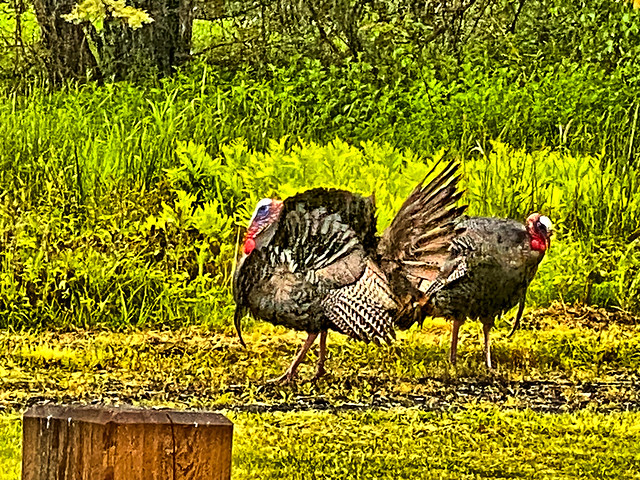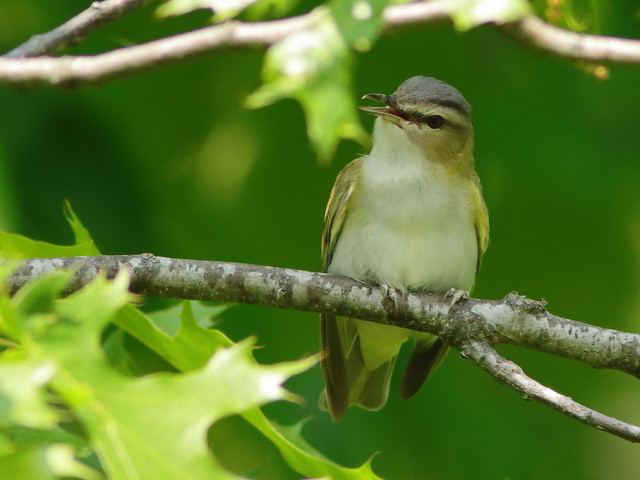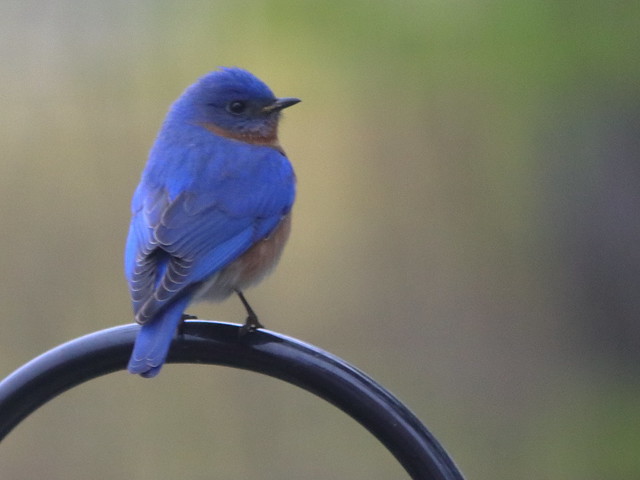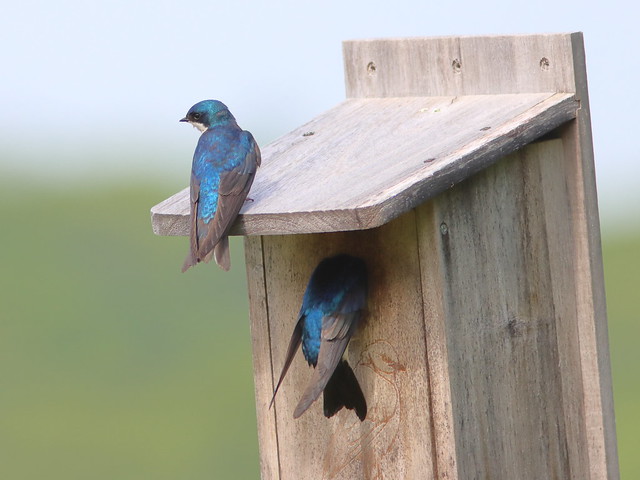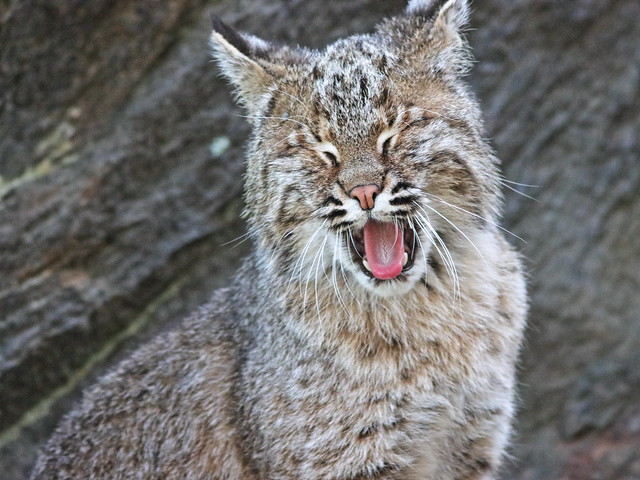The weather had finally improved enough to allow pleasant morning walks through our neighborhood. Almost everyone was out clearing weeds and planting flowers. Last night a cold front came through and temperature this morning is 35°F (1.7 °C) and is expected to go below freezing later in the day.
The bluebirds are frequent visitors to the feeders, which we take inside overnight so as not to attract bears.
A male Eastern Bluebird waited for us to come out and immediately visited the suet cake:
The female bluebird foraged under the feeder...
...and, looking up, impatiently waited her turn:
Tree Swallows have arrived and promptly occupied one of the bluebird houses:
The bluebirds have been visiting the other nest box, but I never saw them bring in any nesting material. The swallows immediately began collecting twigs and dry pine needles. The bluebirds may already have hatchlings, as yesterday I saw both parents carrying in insects and suet..
Last spring the bluebirds fought successfully to evict the Tree Swallows and also an aggressive pair of House Sparrows. So far, the House Sparrows have not shown any interest in the nest box. This is the male:
Overhead, a Red-tailed Hawk soared effortlessly on the breezes...
...and partially closing its wings, dropped suddenly into a glide:
Ruby-throated Hummingbirds have arrived and the species will stay here to breed. So far the feeder has hosted at least three females and this male:
Although Bobcats occupy our area, we had not yet seen one in our yard, until this past weekend, when one showed up for two mornings in a row. The Saturday visitor chased after a squirrel before I could reach for my camera. The chase was captured on our Ring security camera (videos below).
I assumed it to be a female because "she" did not appear to be as big as the males I was accustomed to seeing in Florida, and her "mutton chop sideburns" were not as prominent, but I could be wrong. Luckily, she briefly returned after failing in her quest. She was so close to the window of our front door that her body did not fit inside my viewfinder, causing my photos to appear cropped:
She returned the next morning and seemed to be more interested in the birds than the squirrels. My camera was pressed against the window glass. She looked at me straight in the eye but seemed not to be aware that someone was watching:
Note that there is the body of a blood-engorged tick above her right eye. I assume this was the same Bobcat, but on the previous morning there was a tick over the left eye as visible in the first of this series:
I really wished I had a zoom lens. In Florida I compensated for large subjects by backing away, but this was impossible in my closed quarters. I settled for through-the-window portraits of the beautiful animal:
She licked her nose...
...and yawned, closed her eyes and then exposed her perfect teeth:
Oh, for a wide angle lens, as she crouched and and began to stalk and almost capture an unwary cowbird:
Here are three videos of the first encounter from our Ring camera, on May 13 , best viewed full-screen -- There is a 15 second gap between the first two as the Bobcat began her attack, but the third includes most of the action. Watch the second video to the end as the Bobcat returns to the scene of the near-capture of the squirrel--
The first video starts with the Bobcat sitting quietly on the granite shelf near the center of the screen. She then stalks towards the squirrel and chipmunk near the third step from the bottom. They seem oblivious to the presence of the Bobcat and actually move even nearer:
The second video starts about 15 seconds later, when the Bobcat triggers the camera's motion detector by racing down to the fifth step, nearly catching the squirrel (during the first 1-2 seconds!). The chipmunk hides in the vegetation and at the 00:29 second mark runs across to safety in the shrubs. The Bobcat then returns before walking out through the fence:
This clip is from an adjacent camera facing the back of the house. The squirrel and chipmunk are seen in the right lower corner. At about the 00:49 mark the chipmunk senses danger and runs for cover. The Bobcat fails to catch the squirrel, which reaches the safety of the trees:
Background: The bobcat is the only wild cat found in Connecticut and the most common wild cat in North America. Its status has changed dramatically in our state. Historically, bobcats were not protected in Connecticut and were viewed as a threat to agriculture and game species. The state even had a bounty on bobcats from 1935-1971. By the early 1970s, a large increase in the value of bobcat pelts raised concerns that the population could be overharvested. In addition, deforestation of the state’s landscape that peaked in the 1800s greatly reduced habitat for bobcats and many other wildlife species. In 1972, the bobcat was reclassified as a protected furbearer in Connecticut with no hunting or trapping seasons. MORE
For this week's customary sky photos, I feature the setting sun as seen from our covered patio:
In addition to the above iPhone images, I took a shot with my DSLR and was surprised to see several sun spots (two at the top pole and 3-5 more at the bottom right):
Breezes distorted the surface of the local lake, so I searched my Florida archives for an undistorted reflection of clouds over the Wounded Wetlands in my former neighborhood:
This week's header: View of sunset from lower patio
= = = = = = = = = = = = = = = =
Linking to:
Wordless Wednesday (on Tuesday)
Please visit the links to all these posts to see some excellent photos on display
________________________________________________




